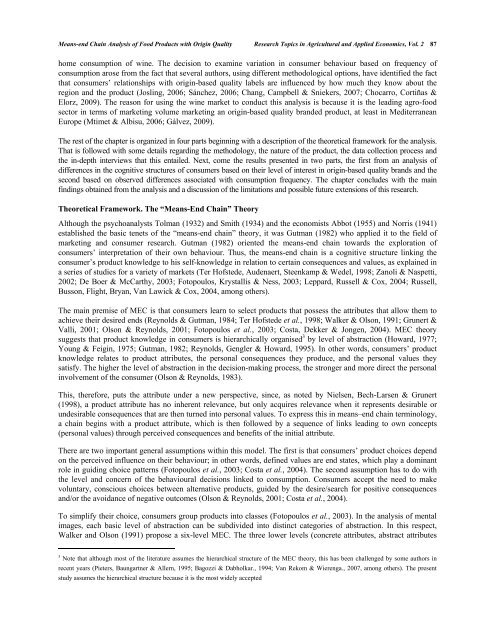chapter 2 - Bentham Science
chapter 2 - Bentham Science
chapter 2 - Bentham Science
You also want an ePaper? Increase the reach of your titles
YUMPU automatically turns print PDFs into web optimized ePapers that Google loves.
Means-end Chain Analysis of Food Products with Origin Quality Research Topics in Agricultural and Applied Economics, Vol. 2 87<br />
home consumption of wine. The decision to examine variation in consumer behaviour based on frequency of<br />
consumption arose from the fact that several authors, using different methodological options, have identified the fact<br />
that consumers’ relationships with origin-based quality labels are influenced by how much they know about the<br />
region and the product (Josling, 2006; Sánchez, 2006; Chang, Campbell & Sniekers, 2007; Chocarro, Cortiñas &<br />
Elorz, 2009). The reason for using the wine market to conduct this analysis is because it is the leading agro-food<br />
sector in terms of marketing volume marketing an origin-based quality branded product, at least in Mediterranean<br />
Europe (Mtimet & Albisu, 2006; Gálvez, 2009).<br />
The rest of the <strong>chapter</strong> is organized in four parts beginning with a description of the theoretical framework for the analysis.<br />
That is followed with some details regarding the methodology, the nature of the product, the data collection process and<br />
the in-depth interviews that this entailed. Next, come the results presented in two parts, the first from an analysis of<br />
differences in the cognitive structures of consumers based on their level of interest in origin-based quality brands and the<br />
second based on observed differences associated with consumption frequency. The <strong>chapter</strong> concludes with the main<br />
findings obtained from the analysis and a discussion of the limitations and possible future extensions of this research.<br />
Theoretical Framework. The “Means-End Chain” Theory<br />
Although the psychoanalysts Tolman (1932) and Smith (1934) and the economists Abbot (1955) and Norris (1941)<br />
established the basic tenets of the “means-end chain” theory, it was Gutman (1982) who applied it to the field of<br />
marketing and consumer research. Gutman (1982) oriented the means-end chain towards the exploration of<br />
consumers’ interpretation of their own behaviour. Thus, the means-end chain is a cognitive structure linking the<br />
consumer’s product knowledge to his self-knowledge in relation to certain consequences and values, as explained in<br />
a series of studies for a variety of markets (Ter Hofstede, Audenaert, Steenkamp & Wedel, 1998; Zanoli & Naspetti,<br />
2002; De Boer & McCarthy, 2003; Fotopoulos, Krystallis & Ness, 2003; Leppard, Russell & Cox, 2004; Russell,<br />
Busson, Flight, Bryan, Van Lawick & Cox, 2004, among others).<br />
The main premise of MEC is that consumers learn to select products that possess the attributes that allow them to<br />
achieve their desired ends (Reynolds & Gutman, 1984; Ter Hofstede et al., 1998; Walker & Olson, 1991; Grunert &<br />
Valli, 2001; Olson & Reynolds, 2001; Fotopoulos et al., 2003; Costa, Dekker & Jongen, 2004). MEC theory<br />
suggests that product knowledge in consumers is hierarchically organised 3 by level of abstraction (Howard, 1977;<br />
Young & Feigin, 1975; Gutman, 1982; Reynolds, Gengler & Howard, 1995). In other words, consumers’ product<br />
knowledge relates to product attributes, the personal consequences they produce, and the personal values they<br />
satisfy. The higher the level of abstraction in the decision-making process, the stronger and more direct the personal<br />
involvement of the consumer (Olson & Reynolds, 1983).<br />
This, therefore, puts the attribute under a new perspective, since, as noted by Nielsen, Bech-Larsen & Grunert<br />
(1998), a product attribute has no inherent relevance, but only acquires relevance when it represents desirable or<br />
undesirable consequences that are then turned into personal values. To express this in means–end chain terminology,<br />
a chain begins with a product attribute, which is then followed by a sequence of links leading to own concepts<br />
(personal values) through perceived consequences and benefits of the initial attribute.<br />
There are two important general assumptions within this model. The first is that consumers’ product choices depend<br />
on the perceived influence on their behaviour; in other words, defined values are end states, which play a dominant<br />
role in guiding choice patterns (Fotopoulos et al., 2003; Costa et al., 2004). The second assumption has to do with<br />
the level and concern of the behavioural decisions linked to consumption. Consumers accept the need to make<br />
voluntary, conscious choices between alternative products, guided by the desire/search for positive consequences<br />
and/or the avoidance of negative outcomes (Olson & Reynolds, 2001; Costa et al., 2004).<br />
To simplify their choice, consumers group products into classes (Fotopoulos et al., 2003). In the analysis of mental<br />
images, each basic level of abstraction can be subdivided into distinct categories of abstraction. In this respect,<br />
Walker and Olson (1991) propose a six-level MEC. The three lower levels (concrete attributes, abstract attributes<br />
3<br />
Note that although most of the literature assumes the hierarchical structure of the MEC theory, this has been challenged by some authors in<br />
recent years (Pieters, Baungartner & Allern, 1995; Bagozzi & Dabholkar., 1994; Van Rekom & Wierenga., 2007, among others). The present<br />
study assumes the hierarchical structure because it is the most widely accepted

















